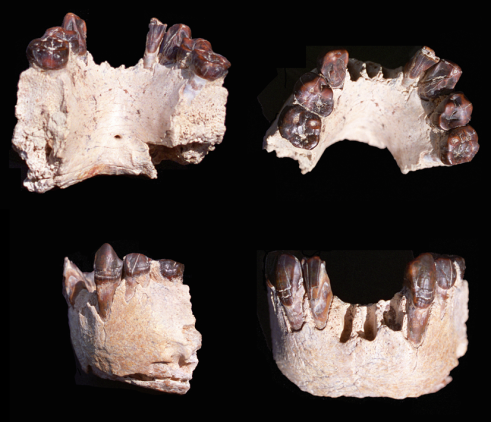Australopithecus bahrelghazali
Background to discovery
Age
Fossil are dated to about 3.6 million years old using beryllium-based radiometric dating, published in 2008.
Important fossil discoveries
Jaw and teeth remains were first discovered in 1995 in Bahr el Ghazal in Chad by a Franco-Chadian team led by palaeontologist Michel Brunet. The type specimen is an adult lower jaw, KT-12/H1. The jaw includes a lower second incisor, both lower canines and all four premolars. Brunet nicknamed the specimen Abel, after his deceased colleague Abel Brillanceau.
Three of the four known fossils were found as part of the 1995-1996 expedition. A fourth fossil mandibular fragment with two teeth was discovered in 2000, a few kilometers south of the earlier site KT13. All four fossils are jaw fragments.
These remains are the first from the genus Australopithecus to be discovered outside of southern and eastern Africa. This enlarges the known geographic range of these hominins.
What the name means
The genus name Australopithecus means ‘southern ape’. The species name is derived from the location that the fossils were found - Bahr el Ghazal in Chad.
Distribution
Ascertaining the distribution of this species is difficult as only four fossils have been found, all from nearby sites in Central Chad in Africa
Relationships with other species
More finds are needed in order to ascertain where this species fits on the human family tree. Its relationship to other australopithecines is debated, but many scientists believe it may be closely related to A.afarensis, with whom it shares numerous characteristics. Others believe it is a sub-species of A.afarensis.
Key physical features
Brain
- lack of cranial remains makes estimates difficult, but the similarities in jaw and teeth features to other australopithecines, suggest the brain would be in the same size range, 400-550 cubic centimetres, as other species in this genus.
Body size and shape
- lack of skeletal remains makes estimates difficult. This species was probably similar in size to modern chimpanzees.
Jaws and teeth
- large incisiform canines and molars
- premolars with 3 roots (rather than 2)
- tooth enamel of a similar thickness to Australopithecus afarensis
- relatively vertical chin compared to other australopithecines (although it is still receding)

© Mission Paléoanthropologique Franco-Tchadienne
Lifestyle
Culture
There is no evidence for any specific cultural attributes but it may have behaved in a manner similar to other australopithecines living in Africa at the same time. It probably used simple tools that included sticks and other non-durable plant materials found in the immediate surroundings. Stones may also have been used as tools, but there is no evidence that stones were shaped or modified in any way. It seems likely that they lived in small social groups containing a mixture of males and females, children and adults.
Environment and diet
This species live in a lakeside environment surrounded by forests, wooded savannah and open grassy patches.
Little work has been done on reconstructing its diet in detail. However, it probably ate mostly plants and may have supplemented this with small amounts of meat.
Further reading:
Brunet, Michel; Beauvilain, Alain; Coppens, Yves; Heintz, É.; Moutaye, A.H.E; Pilbeam, D. (1995). ‘The first australopithecine 2,500 kilometres west of the Rift Valley (Chad)’. Nature. 378 (6554): 273–275.
Lebatard, Anne-Elisabeth; Bourlès, Didier L.; Duringer, Philippe; Jolivet, Marc; Braucher, Régis; Carcaillet, Julien; Schuster, Mathieu; Arnaud, Nicolas; Monié, Patrick; Lihoreau, Fabrice; Likius, Andossa; Taisso Mackaye, Hassan; Vignaud, Patrick; Brunet, Michel (2008). ‘Cosmogenic nuclide dating of Sahelanthropus tchadensis and Australopithecus bahrelghazali: Mio-Pliocene hominids from Chad’. Proc. Natl. Acad. Sci. U.S.A. 105 (9): 3226–3231


